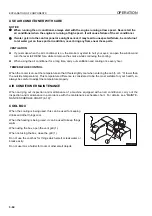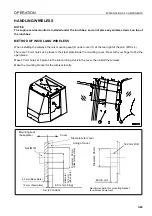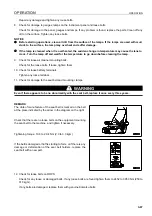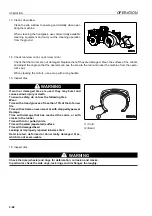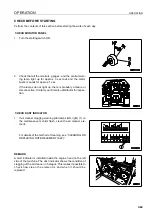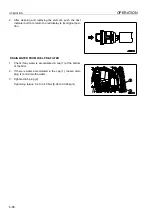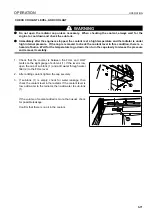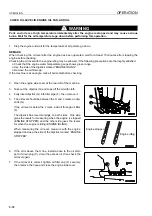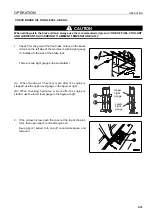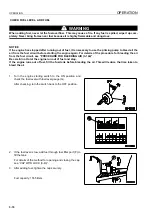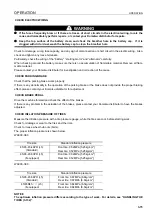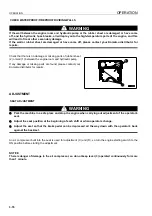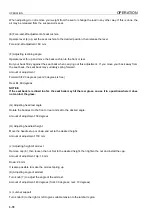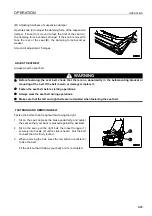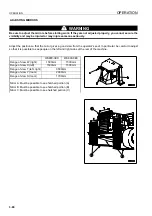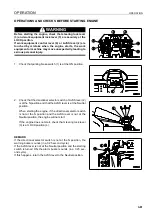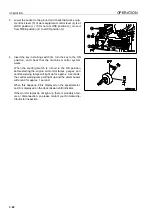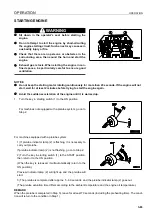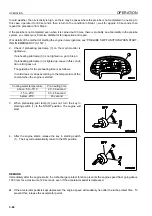
OPERATION
OPERATION
3-77
(A) Fore-and-aft adjustment
Move lever (1) up and move the seat to the desired position
and release the lever.
Fore-and-aft adjustment: 210 mm (10 mm x 21 stages)
(B) Adjusting seat angle
Move lever (2) up, move the seat cushion at the front up or
down to set to the desired position, then release the lever.
Amount of adjustment
Forward tilt: 3 degrees
Rear tilt: 11 degrees
(C) Adjusting seat height
The seat height adjustment uses an air system, and it can be
adjusted steplessly.
When adjusting the height, pull lever (3) up fully or push it down fully (when pulling it up, pull it until a click is felt).
When the seat is set at the desired height, release the lever. If the lever is kept pulled up, the position where the
seat does not rise any further is the maximum height. When the seat reaches the maximum height, the suspen-
sion automatically goes down slightly to secure the amount of movement of the lever.
If the operator raises his body from the seat or changes the amount of weight applied to the seat during adjust-
ment, the air in the suspension may be discharged.
Amount of adjustment: 80 mm
REMARK
If lever (3) is pulled up further from the maximum height, the air compressor may make a sound of actuation but
the seat may not rise. This does not indicate any abnormality.
If this happens, the air compressor will stop automatically after approx. 8 seconds. It will also stop if lever (3) is
pushed down.
(D) Setting seat for weight
To protect the operator, it is necessary to adjust the suspension to match the operator's weight. When carrying out
this adjustment, stop the machine, set the seat to the correct posture, then operate the lever.
Pull up lever (3) lightly a short distance. The weight setting is adjusted automatically. (The air pressure inside the
suspension is increased or decreased to match the operator's weight.)
REMARK
When making initial adjustment or when adjusting the weight settings when operators change shifts, set the damp-
ing force of the suspension damper to the soft setting (for details, see “Adjusting hardness of suspension
damper“), then adjust it to match the operator's weight. If the damping force of the suspension damper is left set to
the hard setting and the height of the seat is adjusted, even if the height is raised, the seat may go down. If the
seat goes down, set the damping force of the suspension damper to the soft setting, lower the seat, then adjust the
weight again. After completing adjustment of the weight and height, set the damping force of the suspension
damper to the desired strength.
To protect the operator, the suspension must be adjusted to match the operator's weight. Adjust the weight before
starting operations.
Summary of Contents for WA800-3E0
Page 2: ......
Page 3: ...FOREWORD 11...
Page 27: ...SAFETY SAFETY LABELS 2 5 LOCATION OF SAFETY LABELS 2...
Page 66: ...GENERAL VIEW OPERATION 3 4...
Page 84: ...EXPLANATION OF COMPONENTS OPERATION 3 22 SWITCHES 3...
Page 224: ...TROUBLESHOOTING OPERATION 3 162...
Page 309: ...SPECIFICATIONS 15...
Page 330: ...HANDLING MACHINES EQUIPPED WITH VHMS ATTACHMENTS OPTIONS 6 20...
Page 331: ...INDEX 17...
Page 332: ...INDEX 7 2...
Page 335: ...COLOPHON 18...


